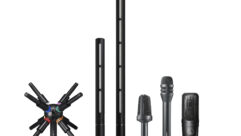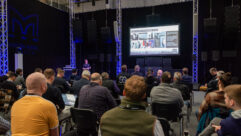
Audio Review: Intelix Audisey Athena
Apr 10, 2009 12:00 PM,
By John McJunkin
Ease of use, power, and small size make for an attractive matrix mixer.

Intelix has introduced its Audisey Athena matrix amplifiers in two configurations: eight inputs by eight outputs or 16 inputs by 16 outputs. The company names numerous audio distribution chores as likely applications for these devices, such as corporate boardroom, council room, house of worship, education, government, retail, themed environment, restaurant, bar, and residential uses. It’s nice to have an onboard DSP in a matrix mixer, but it’s even better to have power amplification in addition to that DSP, and the Athena units do indeed sport that feature.
These units present a Spartan front panel, with only a control section and a 16-character-by-two-line LCD alphanumeric display featured. There is an array of LEDs—eight for the Athena-8 and 16 for the Athena-16—which indicates whether audio is present in the matrix. To the right of this display segment is an extremely simple control section consisting of two buttons labeled “Mode” and “Select” and a data-entry wheel. To the right of these controls is a USB connection.
On the rear panel of each Athena unit is a vast array of I/O, starting at top left with Phoenix-style connectors representing the unit’s inputs (eight on the Athena-8 and 16 on the Athena-16). To the right are more Phoenix-style connectors representing audio-monitor outputs, the number of which again corresponds with the model—eight or 16. In the vertical middle of the left side are computer connections—specifically an RJ-45 Ethernet connector, an ReO bus connector, two RS-232 DB9 connectors, and a PCMCIA card slot. A bank of dipswitches above the slot determines the data transfer rate for the RS-232 interfaces, ranging from 9600 baud to 115,200 baud. The PCMCIA slot facilitates insertion of Intelix’s proprietary Logic I/O card, which provides eight contact-closure inputs and eight 5V logic outputs. Along the bottom of the rear panel—from left to right—are the unit’s IEC power receptacle and switch, two SPDIF I/O pairs, two EDAC modular 20-pin outputs to feed separate Audisey 70V distribution transformers, and eight or 16 (depending on the model) Phoenix-style loudspeaker outputs.
Each Athena input features DSP control of gain and a three-band parametric EQ. Each band’s center frequency can be set at any of the 255 steps between 20Hz and 20kHz. Bandwidth can be adjusted from 0.1 octaves to 2.5 octaves. Maximum cut is -15dB, and maximum boost is +6dB. Each output features high- and low-shelf tone control with corner frequencies adjustable from 20Hz to 20kHz and gain from -15dB to +6dB. For more precise spectral control, there is a five-band parametric EQ on each output channel. Each band, like the three-band EQ on the inputs, features 255 center frequencies between 20Hz and 20kHz with 0.1-octave to 2.5-octave bandwidth and -15dB to +6dB cut or boost maximums, respectively. Output level is also under DSP control, along with digital time delay, ranging from 0 milliseconds to 3.98 milliseconds. Each output channel features a compressor with five adjustable parameters: threshold, variable from 0dB down to -127dB; attack time, variable from 1 milliseconds to 100 milliseconds; release time, also variable from 1 millisecond to 100 milliseconds; ratio, variable from 1:1 to infinity:1 for hard limiting; and gain, variable from 0dB to 20dB. True matrix mixing can be accomplished at each of the 64 crosspoints in the Athena-8 and at each of the 256 crosspoints in the Athena-16. Ramping/slewing and linear/log taper controls are available for matrix mixing, and in linear mixing, the control resolution is 0.4dB per step. Overall gain is variable from -100dB to 0dB. The post-DSP/postmixing outputs feed Class D amplifiers, which facilitate a lot of power without a lot of weight or real estate. Indeed, the Athena units deliver a nice complement of mixing, DSP, and amplification in their 3RU rackmount boxes. They weigh in at 24lbs., which is not bad considering the number of amplifiers onboard. As a matter of fact, I’ll even go out on a limb and say that this is a very robust amount of power from a 3RU unit. Unless you really need substantial SPL, these amplifiers would absolutely do the trick.
Audio Review: Intelix Audisey Athena
Apr 10, 2009 12:00 PM,
By John McJunkin
Ease of use, power, and small size make for an attractive matrix mixer.
The system can be controlled by computer via USB, Ethernet, or an RS-232 serial port if your computer has one. The control application is called Athena Design, and it facilitates control over every parameter on the amplifier. It’s easy to set up inputs and even use presets. The software facilitates naming each input, control of its input gain; determination of whether the channel is being fed by an analog or SPDIF input; DSP; mono or stereo pairing; and channel assignment, level, and panning. Clicking on the green button in the DSP column opens a new window to display the details of that channel’s signal processing. The top of that screen portrays the signal chain from left to right, and clicking on the parametric EQ icon in the center of that chain opens yet another window displaying a frequency-versus-level display that shows the curve of the EQ. The bottom half of the original DSP window displays the overall effect of the EQs a bit larger. Additionally, dragging the lower-right corner of the parametric EQ window expands it as large as your monitor can display it—very nice. In the DSP window on the output side, that larger spectral display at the bottom of the screen is particularly important because it displays the cumulative spectral effect of all EQs and tone controls. It’s nice to see the overall spectral curve of the output. There are also icons for the output-channel delays and compressors. The compressor graphic is of the standard input-versus-output variety, and it nicely portrays the compressor’s settings in a graphical way.
The Athena-16 that I test-drove included four zone-control devices intended for wall-mounting. Intelix makes systems with up to 16 such controls available. The provided controls, made by Intelix partner Calypso Control Systems, featured eight programmable buttons available with graphics that make sense to users. These particular controls offered the input options of a DVD player, computer, microphone, and auxiliary. They also sported mute and level controls. Intelix has gone out of its way to make the programming of these controls as simple as possible to enable smaller and less-sophisticated contractors to land larger, more complex bids.
Related Links

Audio Review: Symetrix Automix Matrix 780
A while back, I took a look at the inaugural product in Symetrix’ Integrator Series, the Zone Mix 760…

Technology Showcase: HOW FOH Mixers
Selecting the best front-of-house mixer for a house of worship is a process that has to take the congregation and worship style of the church into consideration….
Bottom line: I’m very impressed with this system. As I said before, it’s very nice to have matrix mixing, digital signal processing, and amplification all buttoned down in one box. The Class D amps in the Athena system sound great, as does all the digital signal processing. The Intelix Audisey Athena matrix amplifier is definitely worthy of consideration.
John McJunkin is the principal of Avalon Podcasting in Chandler, Ariz. He has consulted in the development of studios and installations, and he provides high-quality podcast-production services.
PRODUCT SUMMARY
- Company: Intelix
www.intelix.com - Product: Audisey Athena
- Pros: Solidly built; nice integration of multiple features.
- Cons: No USB driver for Windows Vista yet.
- Applications: Any audio distribution application.
- Price: $3,440 (Athena-8); $4,957 (Athena-16)
SPECIFICATIONS
Inputs
- Frequency response: ±0.5dB 20Hz-20kHz
- Dynamic range: >105dB
- Crosstalk: Better than -90dB
- Input impedance: 20kV electronically balanced, 10kV unbalanced
- Nominal source impedance: ≤600V
- Nominal input level: +4dBu RMS
- Max input level: +26dBu RMS
- Maximum voltage gain: 60dB
- Equivalent input noise: -129dB @ 50V 20Hz-20kHz (mic preamp stage)
- Phantom power: +15VDC
- Input gain/trim range: 60dB
Outputs
- Monitor output impedance: 440V electronically balanced, 220V unbalanced
- Nominal monitor load impedance: ≥600V
- Nominal level: +4dBu RMS
- Maximum level: +26dBu RMS balanced, +20dBu RMS unbalanced
- Output master volume range: -100dB to 0dB
- Output channel volume range: -88dB to +12dB
- Monitor dynamic range: ≥112dB (IEC-AA) range
- Loudspeaker outputs: 100W/channel max, 400W total per matrix (800W total per matrix for Athen-16), 25V/8V distribution (70V requires Audisey 70V-AM)
- THD+N: <0.05% @ 1W, 8V load, 20Hz-20kHz










